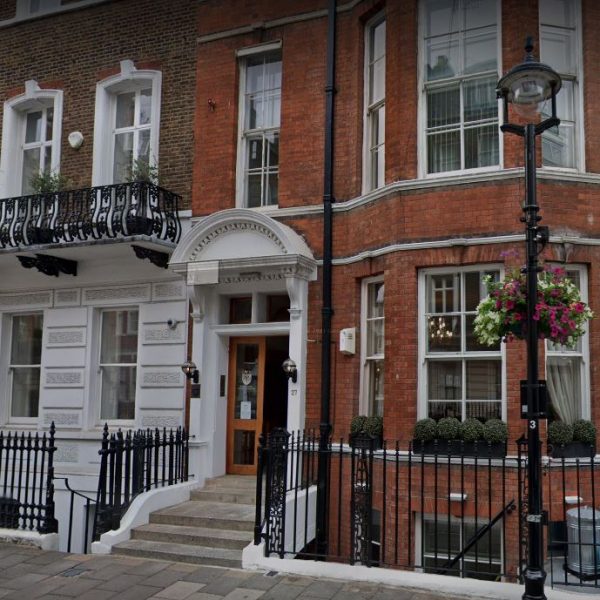Testicular Ultrasound Scan
Private Testicular Ultrasound Scan
Price: £ 197.00
A testicular ultrasound scan is a safe, painless test that uses sound waves to create detailed images of the testicles and scrotum. It helps detect lumps, cysts, varicoceles, infections, and testicular cancer. At Private Ultrasound Clinic, GMC- and HCPC-registered specialists provide same-day appointments, immediate explanations, and full written reports on the day of your scan.
A testicular ultrasound is the first-line imaging test for men with scrotal pain, swelling, or a lump.
- When it’s recommended: testicular lump, pain, swelling, trauma, infertility assessment, or suspected infection.
- What it detects: benign cysts, varicoceles (enlarged veins), hydroceles (fluid around the testicle), epididymo-orchitis (infection), torsion, and testicular cancer.
- Advantages: non-invasive, radiation-free, highly accurate, safe for all ages.
Why choose London Private Ultrasound?
- GMC & HCPC registered sonographers with expertise in men’s health.
- CQC registered clinic with state-of-the-art ultrasound machines.
- Same-day appointments, 7 days a week.
- Clear, transparent pricing: £197.
- Immediate explanation after your scan plus same-day written report.
Book Your Appointment
Please select a location and time slot to proceed with the booking
If you are unable to make a payment online, please call our office to book your appointment. We’re here to assist you!
Tel: 020 7101 3377
Testicular Ultrasound – Frequently Asked Questions (FAQ)
A testicular ultrasound may be recommended if you:
- Notice a lump, swelling, or pain in the testicles or scrotum.
- Have unexplained discomfort or heaviness in the scrotum.
- Experience trauma or injury to the testicles.
- Have fertility concerns or suspected varicocele (enlarged veins).
- Show signs of testicular torsion, infection, or inflammation.
Yes. Ultrasound is the first-line imaging test for assessing testicular lumps. It can distinguish between solid masses (which may be cancerous) and benign conditions such as cysts or fluid collections. However, a definitive diagnosis of cancer requires further tests, such as blood markers or biopsy.
No, the scan itself is not painful. A water-based gel is applied, and a small probe is gently moved over the scrotum. You may feel slight pressure, but the procedure is generally comfortable and well-tolerated.
A testicular ultrasound usually takes 15–20 minutes.
Results are available the same day, often immediately after the scan. A written report is also sent to your doctor or referring clinician for follow-up.
Our Latest Google Reviews
EXCELLENTTrustindex verifies that the original source of the review is Google. Quick and efficient, my ecg report was ready in 10 minutes…Posted onTrustindex verifies that the original source of the review is Google. Wonderful service again. Over and above expectations. Thanks Reza and all the staff that looked after me. See you in a few years.🙏👍Posted onTrustindex verifies that the original source of the review is Google. Very happy with the service. Really appreciated Reza Farahmandfar, he was kind, professional, clear and reassuring.Posted onTrustindex verifies that the original source of the review is Google. fantastic servicePosted onTrustindex verifies that the original source of the review is Google. excellents service for both knee ultrasound in london and cardio review in st albans. would hightly recommendPosted onTrustindex verifies that the original source of the review is Google. Very friendly consultation was excellentPosted onTrustindex verifies that the original source of the review is Google. Great service all round. Very reasonable on price. I had an ECHO done and Dr Valilian is very calm and professional. They do same day or next day appointments including Saturdays. If you any concerns than I would recommend London Private Ultrasound.Posted onTrustindex verifies that the original source of the review is Google. This was the first time I had used this company so was unsure what to expect. I could not be happier with the treatment I received. I was treated with so much respect and supported throughout my scan. Eduardo very quickly found the problem I had been experiencing and I had already received the report and images in my email before I returned home. I would highly recommend this service and would be more than happy to use them again if needed.Posted onTrustindex verifies that the original source of the review is Google. Mr Reza Farahmandfar was absolutely brilliant - professional & informative. Totally relaxed atmosphere with gentle and respectful engagement. Had an arterial Doppler because of my concern (& my acupuncturist’s) of very prominent & raised / inflamed veins in my right leg. Fortunately a positive result - I immediately received the findings with an email with details of the scan & thus prevented any unnecessary worry or treatment. Would highly recommend this clinic since the service was very prompt and at a price which I could afford & I went on a Sunday.Posted onTrustindex verifies that the original source of the review is Google. Really quick and efficient service and made to feel really comfortable.
Private Ultrasound Clinic
All part of our services, from our specialists to our technology and, of course, our clinic, is designed to deliver the greatest possible experience for all of our patients and visitors.
We are conveniently located a stone throw famous Harley Street of London and our clinic is a place where you may feel safe and clean, comfortable, and reassuring environment.
Central London Branch: 27 Welbeck Street, London, W1G 8EN
St Albans Branch : 54-56 Victoria St, St Albans, AL1 3HZ
Tel: 020 7101 3377

Related Products
Testicuar Ultrasound FAQs
This section provides a numbered list of frequently asked questions for Private Testicular Ultrasound Scans:
1. What is a testicular ultrasound?
A testicular ultrasound, also known as a scrotal ultrasound, is a non-invasive medical imaging test that uses high-frequency sound waves to create detailed images of the testicles, epididymis, and the surrounding structures within the scrotum.
2. Why would a doctor order a testicular ultrasound?
A doctor will typically order this test to investigate a range of symptoms or conditions, including:
- A lump or mass in the scrotum.
- Swelling, pain, or discomfort in the testicles.
- Injury or trauma to the testicular area.
- Testicular torsion (a medical emergency where the spermatic cord twists, cutting off blood flow).
- Suspected infection or inflammation (epididymitis or orchitis).
- Infertility issues.
- To locate an undescended testicle.
3. How does the procedure work?
The procedure uses a small, handheld device called a transducer. The transducer sends sound waves into the scrotum, and these waves bounce off the internal structures. A computer then converts the echoes into a real-time image on a monitor, allowing the sonographer or radiologist to see the size, shape, and blood flow within the testicles.
4. Is a testicular ultrasound painful?
The procedure is generally not painful. You may feel slight pressure as the sonographer moves the transducer over the area. If you are experiencing pain or swelling, this pressure may cause some discomfort, but it is a quick and non-invasive test.
5. How do I prepare for a testicular ultrasound?
No special preparation is needed for this test. You can eat and drink as you normally would. It’s a good idea to wear loose-fitting, comfortable clothing. You will be asked to undress from the waist down and will be provided with a drape to maintain privacy.
6. What happens during the procedure?
You will lie on your back on an examination table. The sonographer will place a warm, water-based gel on your scrotum. This gel helps the transducer glide smoothly and improves the transmission of sound waves. The sonographer will then move the transducer over the area to capture images from different angles. They may ask you to hold your breath for a few moments to get clearer images. The room is often dimly lit to help the sonographer see the monitor better.
7. How long does the test take?
The scan is relatively quick, usually taking about 15 to 30 minutes from start to finish.
8. What can the ultrasound show or detect?
A testicular ultrasound can differentiate between various conditions, including:
- Solid masses: These may be benign (like a cyst) or malignant (cancerous).
- Fluid-filled sacs: Conditions like hydroceles (fluid around the testicle) or spermatoceles (sperm-filled cysts) appear as fluid-filled areas.
- Inflammation: The ultrasound can show increased blood flow, which is a sign of infection or inflammation, such as epididymitis or orchitis.
- Lack of blood flow: This is a key indicator of testicular torsion, which is a medical emergency.
- Varicocele: This is a common condition involving enlarged veins within the scrotum, often described as feeling like a “bag of worms.”
9. Can a testicular ultrasound diagnose cancer?
A testicular ultrasound is the primary tool used to determine if a lump is solid (potentially cancerous) or fluid-filled (usually benign). While it cannot definitively diagnose cancer, it provides critical information that helps a urologist decide if further tests (like a blood test for tumor markers) or surgical intervention are necessary.
10. Are there any risks or side effects?
Ultrasound is a very safe procedure. It does not use radiation and has no known harmful side effects. The gel used is hypoallergenic, and an allergic reaction is extremely rare.
11. When will I get my results?
The images from the ultrasound are reviewed by a radiologist, who writes a detailed report. This report is then sent to the doctor who ordered the test, who will discuss the findings and next steps with you. This process can take a few days. For urgent conditions like testicular torsion, the results are typically reviewed immediately.
12. What happens if the ultrasound shows an abnormality?
Based on the ultrasound findings, your doctor will determine the appropriate next steps. For benign conditions like small cysts or varicoceles, they may recommend a “watch and wait” approach. If a solid mass is found, you will likely be referred to a urologist for further evaluation, which may include blood tests or surgery. In cases of testicular torsion, emergency surgery is required to restore blood flow to the testicle.
EXCELLENTTrustindex verifies that the original source of the review is Google. Quick and efficient, my ecg report was ready in 10 minutes…Posted onTrustindex verifies that the original source of the review is Google. Wonderful service again. Over and above expectations. Thanks Reza and all the staff that looked after me. See you in a few years.🙏👍Posted onTrustindex verifies that the original source of the review is Google. Very happy with the service. Really appreciated Reza Farahmandfar, he was kind, professional, clear and reassuring.Posted onTrustindex verifies that the original source of the review is Google. fantastic servicePosted onTrustindex verifies that the original source of the review is Google. excellents service for both knee ultrasound in london and cardio review in st albans. would hightly recommendPosted onTrustindex verifies that the original source of the review is Google. Very friendly consultation was excellentPosted onTrustindex verifies that the original source of the review is Google. Great service all round. Very reasonable on price. I had an ECHO done and Dr Valilian is very calm and professional. They do same day or next day appointments including Saturdays. If you any concerns than I would recommend London Private Ultrasound.Posted onTrustindex verifies that the original source of the review is Google. This was the first time I had used this company so was unsure what to expect. I could not be happier with the treatment I received. I was treated with so much respect and supported throughout my scan. Eduardo very quickly found the problem I had been experiencing and I had already received the report and images in my email before I returned home. I would highly recommend this service and would be more than happy to use them again if needed.Posted onTrustindex verifies that the original source of the review is Google. Mr Reza Farahmandfar was absolutely brilliant - professional & informative. Totally relaxed atmosphere with gentle and respectful engagement. Had an arterial Doppler because of my concern (& my acupuncturist’s) of very prominent & raised / inflamed veins in my right leg. Fortunately a positive result - I immediately received the findings with an email with details of the scan & thus prevented any unnecessary worry or treatment. Would highly recommend this clinic since the service was very prompt and at a price which I could afford & I went on a Sunday.Posted onTrustindex verifies that the original source of the review is Google. Really quick and efficient service and made to feel really comfortable.



